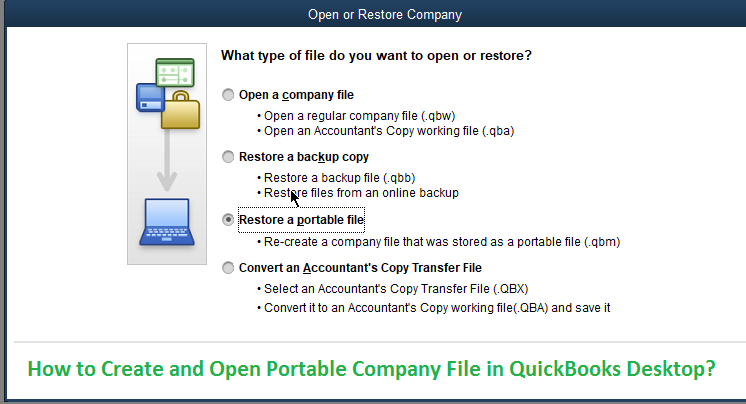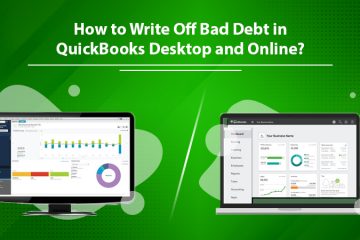How to Create and Open Portable Company File in QuickBooks Desktop?

QuickBooks Portable Company File contains the compact version of your accounting data, to transfer files to other devices through Email, USB, or Hard drive. With the little effort, you can easily create the portable files for QuickBooks, transfer it to other devices and open or restore it quickly.
QuickBooks is one of the dominating account software which is available globally. The program is used widely for tracking money inflow and outflow, payroll functions, paying bills, and manages business payments. Contact QuickBooks Support Number.

QuickBooks Portable Company File
- Portable Company Filesis a compact version of your accounting data.
- The compact size makes it easy to transfer the portable files via Email, USB drive, or hard drive.
- The portable files will have an extension- .qbm; hence your data will appear like this- (qbm)
- These files do not contain your company logo, pictures, or templates.
- Portable document doesn’t contain .log or .tlg file.
- It also doesn’t include a fixed assets file manager and load manager.
- Additionally, restoring the portable files helps in debug various errors in your data, as QuickBooks re-indexes the data automatically.
Note 1: Every time you open the QuickBooks to create and restore/open the portable company file, you will have to login as an admin,
Note 2: You should know that if you provide access to portable files to any other person, then by default, he can reach all the QuickBooks files or add/delete the transactions although Password will be required to access files.
How to Create Portable Company File in QuickBooks?
Before creating the files, the first step should be to update QuickBooks to the latest version. With every new update, the company provides the solution to fix the bugs in the previous version.
You can also check for the new release at QuickBooks desktop. After Hitting F2 on the keyboard, the product information windows will appear, and from there, you can check for the current QB version and latest release (if any). Make sure to check once in a month.
Step 1: Update QuickBooks Software
- Open the QuickBooks program and select the “Help” tab.
- Now choose “Update QuickBooks Desktop”.
- Now select the tab “Update Now”, further you can choose “Reset Update” to clear all the previous updates.
- And click “Get Updates”, now wait for QuickBooks to finish downloading and installation.
- Restart your QuickBooks to save the new program.
Automatic Update- You can also set your QuickBooks to download the latest software automatically.
- Follow the same process as and click the “Options” tab adjacent to Updatenow.
- And select the dots to “Yes” against the “Automatic Update” and “Shared Download”.
Step 2: Create a Backup File
To create a Backup of Portable Company files, follow these simple steps.
- Open your QuickBooks software
- Click “Files” > “Switch to the single user.”
- Again click “Files” > “Create Local Backup” (Under Backup Company)
- After that, click “Local Backup” > “Next” > “Browse” and then navigate to the locations to save your backup file.
- Finally, the system will check the files, and then you will have click “Ok” > “Save it now” > “Next”.
Step 3: Create a Portable Company File
After creating a backup and updating your QuickBooks software to the latest version, you are all set to develop the compact company file. Follow the steps to complete this process.
- Firstly you need to open QuickBooks software on your desktop.
- Further, you need to log in as an Admin with a single-user mode.
- Start with a click on the “File” option from the top-left corner in QuickBooks windows.
- Now from the drop-down list, select the tab “Create Copy”.
- Now choose the “Portable Company files” option in a “save a copy or backup”pop up window.
- Click “Next” to proceed further.
- Now navigate the location (preferably desktop) to save your file, and provide a unique file name. Remember to allot different names to portable files and regular files.
- Now you need to click “Save”.
- Finally, you will have click “Ok” and close the window.
- Now check the location where you have saved the file. It should look like – qbm
Step 4: Open or Restore Portable Company File
To restore or open the Portable files, you will have to access QuickBooks software and login as an admin.
- Now select the “Files” menu.
- After that, choose “Open or Restore Company” from the drop-down list.
- A new window open or restore company will appear, choose “Restore a Portable File”.
- To proceed further, click “Next”.
- Now locate the place where you have saved the portable file.
- Now select the file you want to work upon and click “Open” > “next”.
- Now again, navigate to the location to restore your file and click “Save”.
- Finally, you have to click “Ok” to launch the file,
Bonus Tips for QuickBooks Portable Company File
- It would be best if you give different names to the original data file and portable files; otherwise, the copied version will overwrite the original one.
- Always use an account copy while providing the company files to your accountant.
- Consider creating a backup company file before troubleshooting, to prevent any data loss due to some unprecedented error.
Conclusion
Hopefully, this document might help you to create and open the QuickBooks Portable Company File. The method will provide you a comfortable approach to access files to other devices. Before creating the file, you should update your QuickBooks software and have a backup as well. Further, you can move towards the next processes. If you are finding it difficult or have some other query, then you can contact the QuickBooks Support Number.


